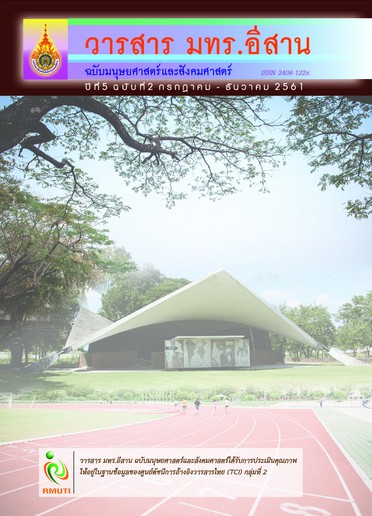Value Added to Agricultural Residues: Local Wisdom for Interior Design Products Development with Corn Husk Rope
Main Article Content
Abstract
This research is a part of an academic service task of the Project entitled Community and Village’s Quality of life Enhancement; Case study of Mae Kasa Village, Mae Sot, Tak Province. The main objective of this research is to (1) Study on Problems, Natural resources management and community environment of Mae Kasa village, Mae-sot District. And (2) to make value added to the agricultural residues through rope development from the corn husk waste through local wisdom. The developed corn husk rope had been used for interior decoration products. Data and information of the relevant natural resource and wastes as well as local wisdom on wickerwork were collected by in-depth interviewing and random sampling from volunteers on natural resource management. It was found out that most farmers have earned their living on corn cultivation, of which corns are sold to the factories. After corn harvesting, corn stumps are burnt that generate air pollution and other environmental pollution causing further impact to the communities. In order to minimize environmental pollution, the study was scoped on the development of wickerwork products from the corn husk residue. The physical properties of the weaved corn husk rope are strong but fl exible with high tension force capacity. Regarding the tension force testing; start applying the tension force at 1 N, the rope would extend to 18 mm. The fi rst rope would be broken at the tension force 927 N, followed by the second and the third ropes, respectively. Such properties could be used as a substitute material for decoration such as table, chair, lamp or interior decoration material. This is the strategy for value added to the agricultural residues which could increase the economic value of the village, Mae Kasa Village, Mae Sot, Tak Province.
Article Details
บทความที่ได้รับการตีพิมพ์เป็นลิขสิทธิ์ของมหาวิทยาลัยเทคโนโลยีราชมงคลอีสาน
ข้อความที่ปรากฏในบทความแต่ละเรื่องในวารสารวิชาการเล่มนี้เป็นความคิดเห็นส่วนตัวของผู้เขียนแต่ละท่านไม่เกี่ยวข้องกับมหาวิทยาลัยเทคโนโลยีราชมงคลอีสานและคณาจารย์ท่านอื่นๆในมหาวิทยาลัยฯ แต่อย่างใด ความรับผิดชอบองค์ประกอบทั้งหมดของบทความแต่ละเรื่องเป็นของผู้เขียนแต่ละท่าน หากมีความผิดพลาดใดๆ ผู้เขียนแต่ละท่านจะรับผิดชอบบทความของตนเองแต่ผู้เดียว
References
จรรยาวรรณ จรรยาธรรม และประทับใจ สิกขา. (2555). การพัฒนาเส้นใยของต้นจากเพื่อใช้ในการออกแบบผลิตภัณฑ์. วารสารวิชาการศิลปะสถาปัตยกรรมศาสตร์ มหาวิทยาลัยนเรศวร. ปีที่ 3, ฉบับที่ 1, หน้า 94-104
โชคชัย เอกทัศนาวรรณ และเกตุอร ทองเครือ. (2560). การปลูกข้าวโพด. เข้าถึงเมื่อ (30 พฤศจิกายน 2560). เข้าถึงได้จาก (https:// www.eto.ku.ac.th/neweto/e-book/plant/herb_gar/corn2.pdf)
ผกามาศ ชูสิทธิ์ และภาณุเดช ขัดเงางาม. (2556). การพัฒนาแผ่นใยไม้อัดซีเมนต์จากการประยุกต์ใช้เส้นใยธรรมชาติจากกากมะพร้าวและต้นข้าวโพด. คณะครุศาสตร์อุตสาหกรรม มหาวิทยาลัยเทคโนโลยีราชมงคลพระนคร
เว็บเพื่อพืชเกษตรไทย. (2560). ข้าวโพดหวาน และการปลูกข้าวโพดหวาน. เข้าถึงเมื่อ (24 มิถุนายน 2560). เข้าถึงได้จาก (https://puechkaset.com/ข้าวโพดหวาน)
เครือข่ายความร่วมมือเพื่อการถ่ายทอดเทคโนโลยีสู่ชุมชน. (2560). การแปรรูปเศษวัสดุเหลือทิ้งจากข้าวโพด. เข้าถึงเมื่อ (30 มิถุนายน 2560). เข้าถึงได้จาก (https://www.clinictech.most.go.th/online/pages/techlist_display.asp?tid=940)
สันทนา อมรไชย. (2552). ผลิตภัณฑ์สีเขียวเพื่อสิ่งแวดล้อมที่ยั่งยืน. วารสารกรมวิทยาศาสตร์บริการ. ปีที่ 57, ฉบับที่ 179, เข้าถึงเมื่อ (18 มิถุนายน 2560). เข้าถึงได้จาก (https://lib3.dss.go.th/fulltext/dss_J/2552_57_179_P29_36.pdf)
สำนักงานกองทุนสนับสนุนการสร้างเสริมสุขภาพ. (2558). เปลี่ยนขยะข้าวโพด เป็นเห็ดฟางปลอดสารพิษ. เข้าถึงเมื่อ (24 มิถุนายน 2560). เข้าถึงได้จาก (https://www.thaihealth.or.th/Content/29404-เปลี่ยนขยะข้าวโพดเป็นเห็ดฟางปลอดสารพิษ.html)
สถาบันพัฒนาสิ่งทอ. (2557). เส้นใยจากลำต้นและใบข้าวโพด (Corn stover). เข้าถึงเมื่อ (12 มิถุนายน 2560). เข้าถึงได้จาก (https://www.thaitextile.org/index.php/blog/2016/08/59plant10.1)
อญัชนา สิงห์รัตนพันธุ์. (2559). เฟอร์นิเจอร์เพื่อการพักผ่อนจากโครงสร้างแรงดึง. วิทยานิพนธ์สาขาวิชาการออกแบบผลิตภัณฑ์ คณะมัณฑนศิลป์ มหาวิทยาลัยศิลปากร
Jame B. Harris, and Kevin Pui K Li. (1996). Masted Structure in Architecture. London: Pinpoint Group Inc
Linda, U. (2004). Turning Husk Into Textiles Could Boost Corn’s Value. Access (16 June 2017). Available (https://ianrnews.unl.edu/static/0403160.shtml)
M. Sfiligoj Smole, S. Hribernik, K. Stana Kleinschek and T. Kreže (2013). Plant Fibres for Textile and Technical Applications. Advances in Agrophysical Research, Prof. Stanisław Grundas (Ed.), InTech, DOI: 10.5772/52372. Available (https://www.intechopen.com/books/advances-inagrophysical-research/plant-fibres-for-textile-and-technical-applications)
Nani, H. A., Norwani, Md. N., and Sarina, M. (2015). Innovation of Corn Husk Fiber into Songket Weaving Towards Sustainability of Cottage Industry. Access (30 November 2017). Available (https://www.researchgate.net/profile/Norwani_Md_Nawawi/publication/273381382_Innovation_of_Corn_Husk_Fiber_into_Songket_Weaving_Towards_Sustainability_of_Cottage_Industry/links/5513aede0cf2eda0df302861/Innovation-of-Corn-Husk-Fiber-into-Songket-Weaving-Towards-Sustainability-of-Cottage-Industry.pdf)
Save OurSea. (2558). สรุปข่าวทะเลและสิ่งแวดล้อม. เข้าถึงเมื่อ (24 มิถุนายน 2560). เข้าถึงได้จาก (https://www.saveoursea.net/forums /showthread.php?t=3495)


